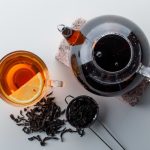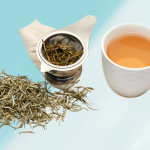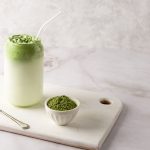
31 May Japanese Tea Culture: the most popular Japanese Teas
Nothing is more representative of Japan than Tea. This drink defines Japanese culture from one end to the other. In Japan, serving tea hot or cold is a cordial rule among the Japanese people, well respected by those who visit. Another uncommon thing is the silent meetings between friends and family.
The famous Chanoyu or Japanese tea ceremony apply by the following principles: WA, KEI, SEI and JAKU (harmony, respect, purity, and tranquillity). A beautiful ritual that begins with a single cup of green tea.
Explore a bit more of Tea Culture and get to know the most popular Japanese teas in the world. And be happy!
Highlights Global Japanese Tea Association – The Cultivation of Japanese Tea
1. “Plants can develop in nature without human intervention. However, the production of the tea we love so much requires human involvement for harvesting the leaves or the strict care of the plants.”;
2. “(…) in Japan, plants are (…) planted and replanted every 40 to 50 years.”;
3. “plants are essentially propagated through cuttings. A cutting is a small part of a branch (usually a shoot) that (…) contains a tea-leaf (…) When a cutting has developed some roots and shoots/branches (usually after 1 or 2 years) it is transplanted into its field.”;
4. “cuttings plants display 100 % of the genetic information of the parent plant (…) seed plants only display 50 % of the genetic information of the parent plant (…) Thus, currently in Japan, most plants are propagated by cuttings.”;
5. “One of the most important activities for the plant is pruning. Plants that are pruned regularly throughout the year remain at an accessible height for harvesting, besides allowing the development of new shoots (…).”;
6. “Considering tea production, harvesting is the most intense period of agricultural activities. In Japan, the harvest runs from spring to autumn, and depending on the area, there may be 3 or 4 harvests (it takes 1 month and 15 days for new shoots to grow)”;
7. “Spring is the most essential season of Japanese tea production, in which the most prized and higher quality teas such as Matcha, Gyokuro and Sencha are produced. (…) During summer (…) the teas produced (…) are of inferior quality. (…) the tea is harvested again in autumn (…) the tea produced (…) is of even lower quality and is (…) used in the production of bags and bottled teas ready for consumption.”
8. “Formerly in Japan (although in some countries it is still the usual practice), the leaves were picked by hand. It takes many hours to pick a small portion of leaves. With the evolution, Japan modernized by introducing machines and new harvesting methods (…) cutting machines were introduced with a cotton bag attached to one end of the machine (…) it was a little more efficient but dependent on human labour. Today, harvesting machines are used. They are handled by two people, one on each side of the plants (…) The machine has two pruning devices with a large bag between them and tubes that channel the air, introducing the cut leaves into the bag. The quantity of leaves harvested corresponds to the work done by 25 to 30 people. Because of their efficiency, they are used in the mountainous areas of Japan”;
9. “In the production of premium quality teas such as Matcha, Gyokuro and Kabuse Sencha another technique is used – shading.”.
Excerpts taken from the Official Website of the “Global Japanese Tea Association”, text written by Simona Zavadckyte and translated by Sílvia Ferreira (Chá Camélia).
Types of Japanese Teas
1. Gyokuro – Green Tea – Ryokucha
Gyokuro is a handmade Japanese green tea that is very special because it is shaded for almost 3 weeks before it is harvested, and this causes the amino acid thiamine to increase, producing a sweeter flavour.
Miyazaki Gyokuro is considered one of Japan’s finest teas, as it is a rarity with unique characteristics. After the first actual harvest, Gyokuro has a mineral-rich composition, promoted by its exposure to winter weather phenomena and the final bush cover. As a rule, the youngest buds and leaves are harvested to obtain the highest concentration of Gyokuro’s properties. Compared to Matcha or Sencha, Gyokuro has a slightly chunkier consistency.
Known as an ‘umami tea’, Gyokuro takes place in the mountainous area of Asahina in Shizuoka City. The processing process for Gyokuro is identical to that of Japanese Sencha Green Tea, one of Japan’s most widely grown green tea varieties. In the world of Japanese-origin teas, Gyokuro represents the purest of the top-quality green tea. Hence, it has a higher monetary value than other green teas.
Gyokuro tea is also special because of its special production and storage characteristics. You must prepare it with pure water and heat it at 50º to obtain a high-quality Gyokuro. Gyokuro tea can help slow down the ageing of the skin and strengthen the immune system. Gyokuro Japanese green tea is thought to have been created in 1835 by “a tea merchant from Tokyo” called Yamato Kahei VI.
2. Sencha – Green Tea – Ryokucha
Japanese Sencha tea translates into the expression “boiled tea” because that it is the result of the process of stopping oxidation by steaming the leaves. Sencha is known as the “child of green teas” full of “inspiration” and “vitality”. Although it represents a traditional tea, Sencha was created in 1738 by tea producer Nagatani Souen. About “70% of the tea is produced throughout Japan”.
Sencha is considered one of the “healthiest teas in the world” due to its low theine content and high antioxidant content. It is characterized by the bright green colour of the leaves and a slightly bitter and intense tea flavour, “with a sour finish”. After the first Sencha harvest (spring, the same time as Matcha and Gyokuro teas), the leaves are exposed to sunlight until summer. Before being packed, they are “lightly steamed, rolled and cooled”. The cooking process takes between 2 and 3 minutes.
3. Bancha – Green Tea – Ryokucha – “Late Harvest Japanese Green Tea”;
4. Hojicha – Japanese Roasted Green Tea;
5. Matcha – Green Tea powder (used in Chanoyu, the famous tea ceremony in Japan);
6. Kamairicha – Japanese Green Tea;
7. Konacha – Japanese Green Tea;
8. Mecha – Japanese Green Tea;
9. Genmaicha – Japanese Green Tea Bancha of top quality mixed in with rice and tufted;
10. Mugicha or “Barley Tea”;
11. Tamaryokucha or Guricha – Japanese Green Tea;
12. Kocha – Japanese Black Tea;
13. Kukicha or “Twing Tea” – Green Tea with the leaves and stalks left over from the Gyokuro harvest;
14. Kuromamecha or “Black Soybean Tea”;
15. Shincha – The first green tea of the year
16. Wakoucha – Japanese Black Tea.
Shinra banshou (森羅万象)
Until the next article!
Chás do Mundo
“A Somantis, Unip. Lda é uma empresa fundada em 2005 e que atua no ramo alimentar, com especial incidência na importação e exportação de chás, plantas medicinais, acessórios, especiarias e produtos biológicos diversos. A nossa empresa faz-se representar pela marca “Chás do Mundo ®” que apresenta uma vasta gama de chás de elevada qualidade, onde conta com mais de 2000 variedades disponíveis, entre chás ortodoxos ou blends de diversas tipologias como o chá verde, chá branco, chá preto, chá vermelho, chá oolong, rooibos, plantas medicinais, tisanas, misturas de frutas, chás em saquetas simples, biológicos e de comércio justo.”








Sorry, the comment form is closed at this time.